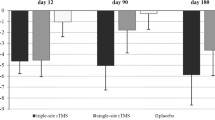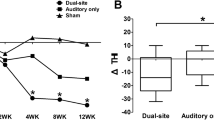Abstract
Low-frequency repetitive transcranial magnetic stimulation (rTMS) of the auditory cortex has been shown to significantly reduce tinnitus severity in some patients. There is growing evidence that a neural network of both auditory and non-auditory cortical areas is involved in the pathophysiology of chronic subjective tinnitus. Targeting several core regions of this network by rTMS might constitute a promising strategy to enhance treatment effects. This study intends to test the effects of a multisite rTMS protocol on tinnitus severity. 45 patients with chronic tinnitus were treated with multisite stimulation (left dorsolateral prefrontal, 2,000 stimuli, 20 Hz; left temporoparietal, 1,000 stimuli, 1 Hz; right temporoparietal, 1,000 stimuli, 1 Hz). Results were compared with a historical control group consisting of 29 patients who received left temporal stimulation (2,000 stimuli, 1 Hz). Both groups were treated on ten consecutive working days. Tinnitus severity was assessed at three time points: at baseline, after the last treatment session (day 12) and after a follow-up period of 90 days. A change of tinnitus severity over time was tested using repeated measures ANOVA with the between-subjects factor treatment group. Both groups improved similarly from baseline to day 12. However, there was a difference on day 90: the multisite stimulation group showed an overall improvement whereas patients receiving temporal stimulation returned to their baseline level of tinnitus severity. These pilot data suggest that multisite rTMS is superior to temporal rTMS and represents a promising strategy for enhancing treatment effects of rTMS in tinnitus. Future studies should explore this new protocol with respect to clinical and neurobiological effects in more detail.


Similar content being viewed by others
References
Adamchic I, Tass PA, Langguth B, Hauptmann C, Koller M, Schecklmann M, Landgrebe M (2012) Linking the tinnitus questionnaire and the subjective clinical global impression: which differences are clinically important? Health Qual Life Outcomes 10(1):79
Adjamian P, Sereda M, Hall DA (2009) The mechanisms of tinnitus: perspectives from human functional neuroimaging. Hear Res 253(1–2):15–31
Beck AT, Steer RA (1984) Internal consistencies of the original and revised Beck depression inventory. J Clin Psychol 40(6):1365–1367
De Ridder D, Elgoyhen AB, Romo R, Langguth B (2011) Phantom percepts: tinnitus and pain as persisting aversive memory networks. Proc Natl Acad Sci USA 108(20):8075–8080
Dehaene S, Changeux J-P (2004) Neural mechanisms for access to consciousness. In: Gazzaniga M (ed) The cognitive neurosciences III. MIT, Cambridge
Eichhammer P, Langguth B, Marienhagen J, Kleinjung T, Hajak G (2003) Neuronavigated repetitive transcranial magnetic stimulation in patients with tinnitus: a short case series. Biol Psychiatry 54(8):862–865
Frank G, Kleinjung T, Landgrebe M, Vielsmeier V, Steffenhagen C, Burger J, Langguth B (2010) Left temporal low-frequency rTMS for the treatment of tinnitus: clinical predictors of treatment outcome-a retrospective study. Eur J Neurol 17(7):951–956
Frank E, Eichhammer P, Burger J, Zowe M, Landgrebe M, Hajak G, Langguth B (2011) Transcranial magnetic stimulation for the treatment of depression: feasibility and results under naturalistic conditions: a retrospective analysis. Eur Arch Psychiatry Clin Neurosci 261(4):261–266
Goebel G, Hiller W (1994) The tinnitus questionnaire. A standard instrument for grading the degree of tinnitus. Results of a multicenter study with the tinnitus questionnaire. HNO 42(3):166–172
Gross M, Nakamura L, Pascual-Leone A, Fregni F (2007) Has repetitive transcranial magnetic stimulation (rTMS) treatment for depression improved? A systematic review and meta-analysis comparing the recent versus the earlier rTMS studies. Acta Psychiatr Scand 116(3):165–173
Hoekstra CEL, Versnel H, Neggers SFW, Niesten MEF, and Van Zanten GA (2012) Effectiveness of bilateral repetitive transcranial magnetic stimulation in patients with chronic tinnitus. Paper presented at the sixth international conference on tinnitus., Bruges, Belgium, p 34
Hoffman RE, Cavus I (2002) Slow transcranial magnetic stimulation, long-term depotentiation, and brain hyperexcitability disorders. Am J Psychiatry 159(7):1093–1102
Hoffman HJ, Reed GW (2004) Epidemiology of tinnitus. In: Snow JB (ed) Tinnitus: Theory and Management. BC Decker Inc, Lewiston, pp 16–41
Hoffman RE, Boutros NN, Hu S, Berman RM, Krystal JH, Charney DS (2000) Transcranial magnetic stimulation and auditory hallucinations in schizophrenia. Lancet 355(9209):1073–1075
Jasper HH (1958) The ten-twenty electrode system of the international federation. Electroencephalogr Clin Neurophysiol 10:371–375
Khedr EM, Rothwell JC, Ahmed MA, El-Atar A (2008) Effect of daily repetitive transcranial magnetic stimulation for treatment of tinnitus: comparison of different stimulus frequencies. J Neurol Neurosurg Psychiatry 79(2):212–215
Khedr EM, Abo-Elfetoh N, Rothwell JC, El-Atar A, Sayed E, Khalifa H (2010) Contralateral versus ipsilateral rTMS of temporoparietal cortex for the treatment of chronic unilateral tinnitus: comparative study. Eur J Neurol 17(7):976–983
Kleinjung T, Fischer B, Langguth B, Sand PG, Hajak G, Dvorakova J, Eichhammer P (2007a) Validierung einer deutschsprachigen Version des “Tinnitus Handicap Inventory”. Psychiat Prax 34(1):140–142
Kleinjung T, Steffens T, Sand P, Murthum T, Hajak G, Strutz J, Eichhammer P (2007b) Which tinnitus patients benefit from transcranial magnetic stimulation? Otolaryngol Head Neck Surg 137(4):589–595
Kleinjung T, Eichhammer P, Landgrebe M, Sand P, Hajak G, Steffens T, Langguth B (2008) Combined temporal and prefrontal transcranial magnetic stimulation for tinnitus treatment: a pilot study. Otolaryngol Head Neck Surg 138(4):497–501
Kleinjung T, Steffens T, Landgrebe M, Vielsmeier V, Frank E, Hajak G, Langguth B (2009) Levodopa does not enhance the effect of low-frequency repetitive transcranial magnetic stimulation in tinnitus treatment. Otolaryngol Head Neck Surg 140(1):92–95
Kleinjung T, Steffens T, Landgrebe M, Vielsmeier V, Frank E, Burger J, Langguth B (2011) Repetitive transcranial magnetic stimulation for tinnitus treatment: no enhancement by the dopamine and noradrenaline reuptake inhibitor bupropion. Brain Stimul 4(2):65–70
Kreuzer PM, Landgrebe M, Schecklmann M, Poeppl TB, Vielsmeier V, Hajak G, Langguth B (2011) Can temporal repetitive transcranial magnetic stimulation be enhanced by targeting affective components of tinnitus with frontal rTMS? A randomized controlled pilot trial. Front Syst Neurosci 5:88
Landgrebe M, Zeman F, Koller M, Eberl Y, Mohr M, Reiter J, Langguth B (2010) The tinnitus research initiative (TRI) database: a new approach for delineation of tinnitus subtypes and generation of predictors for treatment outcome. BMC Med Inform Decis Mak 10:42
Langguth B (2011) A review of tinnitus symptoms beyond ‘ringing in the ears’: a call to action. Curr Med Res Opin 27(8):1635–1643
Langguth B, Zowe M, Landgrebe M, Sand P, Kleinjung T, Binder H, Eichhammer P (2006) Transcranial magnetic stimulation for the treatment of tinnitus: a new coil positioning method and first results. Brain Topogr 18(4):241–247
Langguth B, Goodey R, Azevedo A, Bjorne A, Cacace A, Crocetti A, Vergara R (2007) Consensus for tinnitus patient assessment and treatment outcome measurement: tinnitus research initiative meeting, Regensburg, July 2006. Prog Brain Res 166:525–536
Lanting CP, de Kleine E, van Dijk P (2009) Neural activity underlying tinnitus generation: results from PET and fMRI. Hear Res 255(1–2):1–13
Lehner A, Schecklmann M, Landgrebe M, Kreuzer PM, Poeppl TB, Frank E, Langguth B (2012) Predictors for rTMS response in chronic tinnitus. Front Syst Neurosci 6:11
Newman CW, Jacobson GP, Spitzer JB (1996) Development of the tinnitus handicap inventory. Arch Otolaryngol Head Neck Surg 122(2):143–148
Plewnia C (2011) Brain stimulation: new vistas for the exploration and treatment of tinnitus. CNS Neurosci Ther 17(5):449–461
Plewnia C, Reimold M, Najib A, Brehm B, Reischl G, Plontke SK, Gerloff C (2007) Dose-dependent attenuation of auditory phantom perception (tinnitus) by PET-guided repetitive transcranial magnetic stimulation. Hum Brain Mapp 28(3):238–246
Plewnia C, Vonthein R, Wasserka B, Arfeller C, Naumann A, Schraven SP, Plontke SK (2012) Treatment of chronic tinnitus with theta burst stimulation: a randomized controlled trial. Neurology 78(21):1628–1634
Roberts LE, Eggermont JJ, Caspary DM, Shore SE, Melcher JR, Kaltenbach JA (2010) Ringing ears: the neuroscience of tinnitus. J Neurosci 30(45):14972–14979
Rossi S, De Capua A, Ulivelli M, Bartalini S, Falzarano V, Filippone G, Passero S (2007) Effects of repetitive transcranial magnetic stimulation on chronic tinnitus: a randomised, crossover, double blind, placebo controlled study. J Neurol Neurosurg Psychiatry 78(8):857–863
Schlee W, Hartmann T, Langguth B, Weisz N (2009a) Abnormal resting-state cortical coupling in chronic tinnitus. BMC Neurosci 10:11
Schlee W, Mueller N, Hartmann T, Keil J, Lorenz I, Weisz N (2009b) Mapping cortical hubs in tinnitus. BMC Biol 7:80
Schlee W, Lorenz I, Hartmann T, Müller N, Schulz H, Weisz N (2011) A global brain model of tinnitus. In: Moller AR (ed) Textbook of tinnitus. Springer, New York, pp 161–169
Speer AM, Kimbrell TA, Wassermann EM, Repella JD, Willis MW, Herscovitch P, Post RM (2000) Opposite effects of high and low frequency rTMS on regional brain activity in depressed patients. Biol Psychiatry 48(12):1133–1141
Tracy DK, O’Daly O, Joyce DW, Michalopoulou PG, Basit BB, Dhillon G, Shergill SS (2010) An evoked auditory response fMRI study of the effects of rTMS on putative AVH pathways in healthy volunteers. Neuropsychologia 48(1):270–277
van der Loo E, Gais S, Congedo M, Vanneste S, Plazier M, Menovsky T, De Ridder D (2009) Tinnitus intensity dependent gamma oscillations of the contralateral auditory cortex. PLoS ONE 4(10):e7396
Weisz N, Moratti S, Meinzer M, Dohrmann K, Elbert T (2005) Tinnitus perception and distress is related to abnormal spontaneous brain activity as measured by magnetoencephalography. PLoS Med 2(6):e153
Weisz N, Dohrmann K, Elbert T (2007) The relevance of spontaneous activity for the coding of the tinnitus sensation. Prog Brain Res 166:61–70
Acknowledgments
We thank Helene Niebling and Sandra Pfluegl for their technical assistance in administering rTMS and collecting data. Parts of this study were funded by a grant from the tinnitus research initiative (TRI). Astrid Lehner is supported by a Grant from the American Tinnitus Association (ATA).
Author information
Authors and Affiliations
Corresponding author
Rights and permissions
About this article
Cite this article
Lehner, A., Schecklmann, M., Poeppl, T.B. et al. Multisite rTMS for the Treatment of Chronic Tinnitus: Stimulation of the Cortical Tinnitus Network—A Pilot Study. Brain Topogr 26, 501–510 (2013). https://doi.org/10.1007/s10548-012-0268-4
Received:
Accepted:
Published:
Issue Date:
DOI: https://doi.org/10.1007/s10548-012-0268-4




